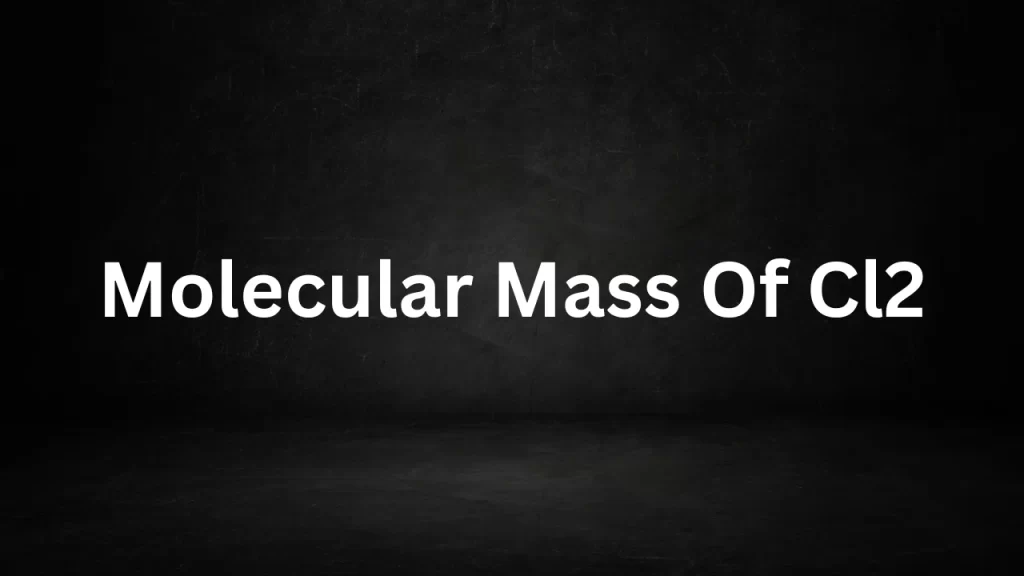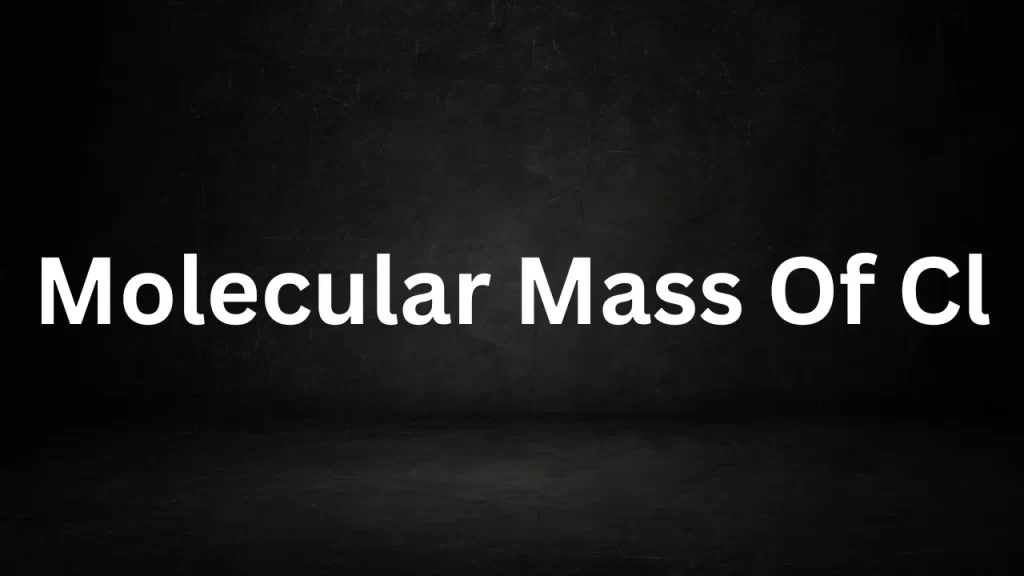Tag: chlorine molecular weight
Molecular Mass Of Cl2
Molecular Mass Of Cl2: Chlorine gas, represented as Cl2, is a diatomic molecule composed of two chlorine (Cl) atoms covalently bonded together.
Understanding the mole mass of Cl2 is fundamental in various scientific, industrial, and environmental applications. In this article, we will explore the mole mass of Cl2, its composition, and its relevance in different fields.

Molecular Mass Of Cl2
The Composition of Chlorine Gas
Chlorine gas (Cl2) consists of two chlorine (Cl) atoms bonded together. Chlorine gas is a gas that appears pale greenish-yellow and has a distinctive, pungent odor. It is widely employed across various industries, including water treatment, disinfection, and chemical synthesis, among others.
Calculating the Molecular Mass
To calculate the mole mass of Cl2, we need to consider the atomic masses of chlorine (Cl). The atomic mass of chlorine (Cl) is approximately 35.453 atomic mass units (amu).
The molar mass, also known as molar weight, of Cl2 is determined by summing the atomic masses of its constituent elements.
Molecular Mass of Cl2 = 2 × Atomic Mass of Cl Molecular Mass of Cl2 = 2 × 35.453 amu Molecular Mass of Cl2 ≈ 70.906 amu
Therefore, the molar mass of chlorine gas (Cl2) is approximately 70.906 atomic mass units (amu) or 70.906 grams per mole (g/mol).
Significance of Cl2’s Molecular Mass
- Water Treatment: Chlorine gas is commonly used to disinfect water in municipal water treatment facilities. Its molecular mass is essential in calculating the required dosage for effective disinfection.
- Chemical Synthesis: Chlorine gas finds application in manufacturing various chemicals, including PVC (polyvinyl chloride), pesticides, and solvents production. Its molecular mass is crucial in reaction stoichiometry.
- Environmental Monitoring: Monitoring chlorine gas emissions in industrial processes and understanding its molecular mass are essential for assessing and controlling environmental impact.
- Healthcare: Chlorine gas exposure can be harmful to human health. The assessment of health risks related to exposure and the development of safety measures take into account its molecular mass.
- Material Compatibility: Understanding the mole mass of Cl2 is important in materials science to assess the compatibility and resistance of materials used in chlorine-handling equipment.
Conclusion
Chlorine gas, with its mole mass of approximately 70.906 atomic mass units (amu), is a versatile chemical compound with a wide range of applications in water treatment, chemical synthesis, and various industries. Although it serves as a valuable tool for disinfection and chemical processes, it also presents challenges concerning safety and environmental impact.. As we continue to rely on chlorine gas for various purposes, understanding its molecular mass remains a fundamental aspect of its safe and effective use in scientific, industrial, and environmental contexts.
Read More
- Molecular Weight Of K
- Molecular Mass Of Iron
- Molecular Weight Of NH3
- Molecular Mass Of Methane
- Molecular Mass Of N2
Frequently Asked Questions (FAQs) On Molecular Mass Of Cl2
1. What is Cl2, and why is its molecular mass important?
Cl2 is chlorine gas, composed of two chlorine (Cl) atoms. Its mole mass is crucial in various scientific, industrial, and environmental applications.
2. How does the molecular mass of Cl2 relate to environmental monitoring?
Understanding the molecular mass of Cl2 is crucial for monitoring emissions in industrial processes and assessing its environmental impact.
3. What are the health implications of chlorine gas exposure, and how does its molecular mass factor in?
Exposure to chlorine gas poses health risks, and its molar mass is a vital factor to consider when assessing these hazards and implementing safety measures.
4. Why is the molecular mass of Cl2 important in materials science?
In materials science, the molar mass of Cl2 is employed to assess the compatibility and longevity of materials employed in equipment intended for chlorine handling.
5. Are there particular analytical techniques that utilize the molar mass of Cl2?
Indeed, the molar mass of Cl2 plays a role in various analytical methods, including mass spectrometry, which aids in identifying and quantifying chlorine-containing compounds within samples.
Molecular Mass Of Cl
Molecular Mass Of Cl: Chlorine, with the chemical symbol Cl, is a highly reactive chemical element classified under the halogen group in the periodic table.
Understanding the mole mass of chlorine is fundamental in chemistry, as it forms the basis for various scientific calculations and is essential for comprehending the properties and behavior of chlorine compounds.
This article will delve into the concept of mole mass, explain how it relates to chlorine, and discuss the significance of this knowledge in both theoretical and practical contexts.

Molecular Mass Of Cl
Molecular Mass: An Overview
The mole mass, also known as molar mass, is a fundamental concept in chemistry. It represents the mass of one mole of a particular substance and is typically expressed in atomic mass units (amu) or grams per mole (g/mol). A mole is a unit used to quantify the amount of a substance and contains approximately 6.022 x 10^23 entities, known as Avogadro’s number. Molecular mass is numerically equivalent to the atomic or mole weight of the substance.
The Molecular Mass of Chlorine (Cl)
Chlorine exists naturally as two stable isotopes: chlorine-35 (^35Cl) and chlorine-37 (^37Cl). The atomic masses of these isotopes are as follows:
- The atomic mass of chlorine-35 is approximately 34.97 amu.
- The atomic mass of chlorine-37 is approximately 36.97 amu.
To calculate the mole mass of chlorine (Cl), we consider the weighted average of the isotopic masses, taking into account their natural abundance. In the case of chlorine, approximately 75.77% is chlorine-35, and about 24.23% is chlorine-37.
mole Mass of Chlorine (Cl) = (0.7577 * Atomic Mass of ^35Cl) + (0.2423 * Atomic Mass of ^37Cl)
mole Mass of Chlorine (Cl) ≈ (0.7577 * 34.97 amu) + (0.2423 * 36.97 amu)
The mole Mass of Chlorine (Cl) ≈ 26.52 amu + 8.96 amu ≈ 35.48 amu
Significance of Molecular Mass of Chlorine
Understanding the mole mass of chlorine is significant in various scientific and practical applications:
1. Chemical Reactions:
- The mole mass of chlorine is crucial in chemical reactions involving chlorine compounds. It helps determine the stoichiometry, allowing chemists to balance equations and calculate reactant and product quantities accurately.
2. Analytical Chemistry:
- In analytical chemistry, the knowledge of molecular mass aids in the determination of concentrations, particularly in techniques like mass spectrometry and atomic spectroscopy.
3. Industrial Applications:
- Chlorine and its compounds have numerous industrial applications, including water treatment, the production of plastics, and the manufacture of chemicals. Knowledge of molecular mass is vital for precise formulation and quality control.
4. Environmental Sciences:
- mole mass plays a role in environmental studies, such as analyzing air and water composition, especially when evaluating chlorine’s impact on ecosystems and public health.
5. Medicine and Healthcare:
- Chlorine-based disinfectants are used in healthcare settings. Understanding mole mass is essential for medication formulations, water treatment processes, and ensuring the safety of medical products.
6. Material Science:
- Molecular mass is relevant in material science, especially when studying polymers and composite materials that may contain chlorine-based additives.
Conclusion
The mole mass of chlorine (Cl) is a fundamental concept in chemistry with wide-ranging applications across various scientific disciplines and industries. It enables precise calculations, facilitates the formulation of chemicals, contributes to environmental assessments, and plays a vital role in fields ranging from healthcare and water treatment to materials science and industrial chemistry. By comprehending the molecular mass of chlorine, scientists, chemists, and professionals can make informed decisions and contributions to diverse fields, ultimately benefiting society and advancing our understanding of the natural and engineered worlds.
Read More
- Molecular Mass Of Acetic Acid
- Molecular Weight Of Calcium Carbonate
- Molecular Weight Of Sodium Hydroxide
- Molecular Weight Of Aluminium
- Molecular Weight Of CaCl2
Frequently Asked Questions (FAQs) On Molecular Mass Of Cl
1. What is the molecular mass of chlorine (Cl)?
The mole mass of chlorine (Cl) is approximately 35.48 atomic mass units (amu). This value represents the weighted average of the two stable isotopes of chlorine, chlorine-35 and chlorine-37.
2. How is the molecular mass of chlorine calculated?
The mole mass of chlorine is calculated by considering the weighted average of the atomic masses of its naturally occurring isotopes, chlorine-35 and chlorine-37, taking into account their respective abundances.
3. Why is the molecular mass of chlorine important in chemistry?
The mole mass of chlorine is essential in chemistry as it helps determine the quantities of chlorine involved in chemical reactions, enabling accurate stoichiometric calculations and the balanced formulation of chemical equations.
4. What is the significance of the molecular mass of chlorine in analytical chemistry?
In analytical chemistry, knowledge of the mole mass of chlorine is crucial for determining concentrations of chlorine compounds, especially when using techniques like mass spectrometry and atomic spectroscopy.
5. Are there industrial applications related to the molecular mass of chlorine?
Yes, chlorine and its compounds have various industrial applications, including water treatment, plastics manufacturing, and chemical production. Understanding mole mass is vital for precise formulation and quality control in these industries.